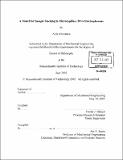| dc.contributor.advisor | Daniel J. Ehrlich. | en_US |
| dc.contributor.author | Srivastava, Alok Kumar, 1967- | en_US |
| dc.contributor.other | Massachusetts Institute of Technology. Dept. of Mechanical Engineering. | en_US |
| dc.date.accessioned | 2006-03-24T18:03:18Z | |
| dc.date.available | 2006-03-24T18:03:18Z | |
| dc.date.copyright | 2002 | en_US |
| dc.date.issued | 2002 | en_US |
| dc.identifier.uri | http://hdl.handle.net/1721.1/29922 | |
| dc.description | Thesis (Ph. D.)--Massachusetts Institute of Technology, Dept. of Mechanical Engineering, 2002. | en_US |
| dc.description | Includes bibliographical references (leaves 129-135). | en_US |
| dc.description.abstract | Sanger's method of chain termination is the method of choice in DNA sequencing, where electrophoresis is used to separate the different sized DNA. In the past decade, microfabricated capillary devices have been developed and are increasingly used to perform DNA electrophoresis. While tremendous progress has been made in the process, sample injection has not been well understood. In an earlier study, images of sample injection obtained using video microscopy showed sharp sample stacking peak at the trailing edge of the sample plug. This thesis examines the underlying physics that explain the behavior of DNA in microcapillary electrophoresis. A developed model captures the dynamics of the major electrolytes in the system. The applied voltage and the conductivity profile determine the local electric field. The electric field drives the analyte transport. The analyte consists of DNA molecules of various fragment sizes. Since the DNA concentration is smaller than the electrolyte concentration by a few orders of magnitude, its concentration does not affect the conductivity. The major components of the sample are identified, and role during injection is investigated. Analytical studies of the electrolyte boundary dynamics and evolution and the transport of DNA are presented. The effect of the buffer, applied voltage during injection, and sample mobility on stacking are shown. | en_US |
| dc.description.abstract | (cont.) A numerical model is implemented to quantitatively predict the stacking of DNA in microcapillary electrophoresis. The numerical model has been developed for the 1-dimensional case. The model is verified using analytical results. Results of numerical models that predict the behavior of DNA under experimental conditions are presented. The numerical model is compared with real experimental data to evaluate its predictive power. Preliminary numerical simulations have also been done for 2-dimensional geometries. A procedure has been developed for design of injector lengths to obtain a given resolution of separation in a microcapillary channel of specified length. Strategies for optimization are presented for improving the performance of the devices. | en_US |
| dc.description.statementofresponsibility | by Alok Srivastava. | en_US |
| dc.format.extent | 161 leaves | en_US |
| dc.format.extent | 6178305 bytes | |
| dc.format.extent | 6178114 bytes | |
| dc.format.mimetype | application/pdf | |
| dc.format.mimetype | application/pdf | |
| dc.language.iso | eng | en_US |
| dc.publisher | Massachusetts Institute of Technology | en_US |
| dc.rights | M.I.T. theses are protected by copyright. They may be viewed from this source for any purpose, but reproduction or distribution in any format is prohibited without written permission. See provided URL for inquiries about permission. | en_US |
| dc.rights.uri | http://dspace.mit.edu/handle/1721.1/7582 | |
| dc.subject | Mechanical Engineering. | en_US |
| dc.title | A model for sample stacking in microcapillary DNA electrophoresis | en_US |
| dc.type | Thesis | en_US |
| dc.description.degree | Ph.D. | en_US |
| dc.contributor.department | Massachusetts Institute of Technology. Department of Mechanical Engineering | |
| dc.identifier.oclc | 51849622 | en_US |
